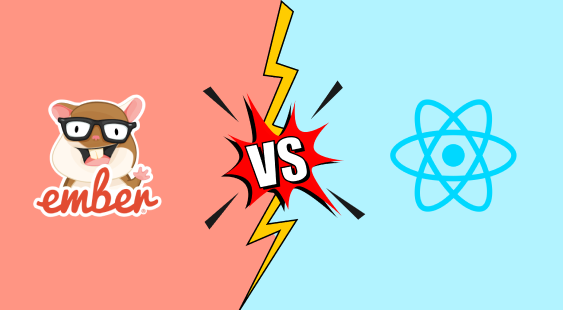🚀 Ember vs. React: The Epic Showdown
 Sridhar Murali
Sridhar Murali
In the ever-evolving realm of frontend development, choosing the right framework can be a daunting task. Two giants in the field, Ember.js and React.js, stand out prominently, each with its own set of strengths and weaknesses. As someone deeply entrenched in this dynamic landscape, I've had the opportunity to work extensively with both frameworks. In this blog post, I'll share my insights and provide a nuanced perspective on the debate between Ember and React.
ROUND 1 - Ease of Use:
Ember: Known for its convention over configuration approach, Ember provides a structured environment that facilitates rapid development. Its CLI (Command Line Interface) offers a suite of tools and predefined patterns, making it beginner-friendly.
React: React's simplicity lies in its minimalist approach. With JSX, a JavaScript syntax extension, React components closely resemble HTML, easing the learning curve for developers familiar with web development.
KO: While Ember offers a more opinionated approach, React's flexibility allows for greater customization. The choice depends on the project's requirements and the team's preferences.
ROUND 2 - Community Support:
Ember: Backed by a robust community, Ember boasts extensive documentation, regular updates, and a plethora of plugins and addons.
React: With the backing of Facebook and a vast community of developers worldwide, React enjoys widespread adoption and continuous support.
KO: Both frameworks have thriving communities, but React's sheer popularity translates to a broader range of resources and support available.
ROUND 3 - Class-based in Ember vs. Functional Components in React:
Ember: Traditionally, Ember relies on class-based components, offering a structured and familiar programming model for those coming from object-oriented backgrounds.
React: React embraces functional components as the preferred way of building UI elements, promoting a more declarative and composable approach.
KO: The shift towards functional components in React aligns with modern JavaScript paradigms and simplifies state management. However, Ember's class-based approach may resonate better with developers accustomed to traditional frameworks.
ROUND 4 - Scalability:
Ember: With its opinionated architecture and built-in solutions for routing, state management, and data fetching, Ember excels in handling large-scale applications.
React: React's lightweight core and vast ecosystem of libraries enable developers to tailor solutions to specific scalability requirements.
KO: Both frameworks are capable of scaling to meet the demands of complex applications. Ember's convention-driven approach may offer a smoother scaling experience for teams seeking out-of-the-box solutions.
ROUND 5 - Third-party Package Availability:
Ember: While Ember's ecosystem is robust, it may not match the breadth and depth of React's extensive library of third-party packages.
React: React's popularity has led to a thriving ecosystem of libraries and tools, offering solutions for virtually every aspect of frontend development.
KO: React's vast ecosystem provides unparalleled flexibility and extensibility, making it an attractive choice for projects requiring diverse functionalities.
ROUND 6 - Job Opportunities:
Ember: While Ember has a loyal user base and is widely used in certain industries, React's dominance in the market translates to a broader range of job opportunities.
React: With its widespread adoption by tech giants and startups alike, React developers are in high demand across industries.
KO: React's popularity and market demand make it a safer bet for developers seeking career opportunities in the frontend development landscape.
Finish Him
In conclusion, the choice between Ember and React ultimately boils down to the specific needs and preferences of the development team. While Ember offers a structured and opinionated approach, React's flexibility and extensive ecosystem make it a powerhouse in the frontend development arena. Whether you opt for Ember's convention or React's flexibility, both frameworks empower developers to craft exceptional user experiences in the ever-evolving world of web development.
_______ Wins !!!
In addition to the points discussed, it's essential to note that the trajectory of framework development can significantly impact the developer experience and project outcomes. While Ember's convention-driven approach provides stability and predictability, there's a risk of development practices becoming stagnant or saturated over time. On the other hand, React's dynamic ecosystem continually evolves, introducing new paradigms and tools to enhance productivity and address emerging challenges. A prime example is Next.js, a framework built on top of React, which pushes the boundaries of frontend development by offering server-side rendering, static site generation, and other innovative features out of the box. This forward-thinking mindset keeps React developers engaged and empowered to explore new possibilities, driving the framework's continued growth and relevance in the ever-changing landscape of web development.
Subscribe to my newsletter
Read articles from Sridhar Murali directly inside your inbox. Subscribe to the newsletter, and don't miss out.
Written by

Sridhar Murali
Sridhar Murali
Passionate Frontend Engineer with over 4.5 years of experience in frontend development and a strong previous experience in Quality Assurance of 4 years (2016-2020). Skilled in building responsive, high-quality applications using JavaScript frameworks like Ember.js and React.js, combining meticulous attention to detail from a QA background with a commitment to delivering seamless user experiences. Recognized for writing efficient, accessible code, strong debugging skills